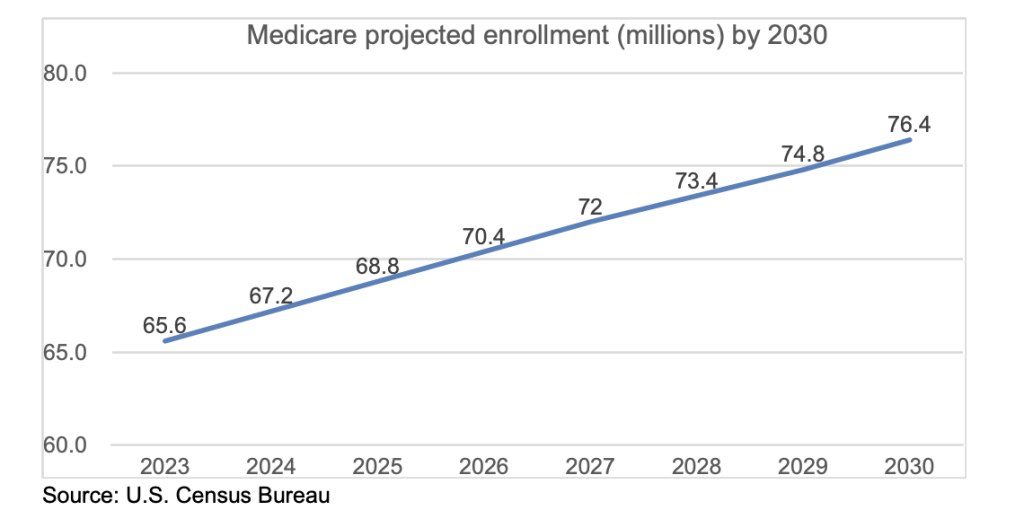By Danny Schmidt, Michael Haas and Matt Wolf, health care senior analysts with RSM US LLP
Home health care services have boomed, primarily driven by aging Americans who demand more convenient and less expensive care and do not want to move into traditional independent or assisted living senior housing. However, as labor remains tight and margins compress, home health providers may struggle to sustainably operate, let alone expand into new markets. Providers will need to address new challenges in new ways to thrive and grow.
The latest U.S. Census Bureau data indicates there are approximately 76.4 million baby boomers and all will be fully eligible for Medicare by 2030. This steady surge of senior population has created a booming demand in the home health care industry as these aging Americans require various services from health monitoring and nursing care to occupational therapy and skilled care. Home health care is positioned to provide the answer for much of this growing demand by offering flexibility and convenience to consumers along the continuum of care.

And now the advancement in technology and care techniques can provide further opportunities for home health providers to reach this growing senior population.
Home health care’s value
Home health care can save money and improve outcomes by treating certain patients in the comfort of their own home. Home health care includes a broad range of services provided by skilled medical professionals, including skilled nursing care, physical therapy, occupational therapy and speech therapy. Home health care can also include skilled, non-medical care, such as medical social services or assistance with daily living from a highly qualified home health aide.
Not only do many patients prefer receiving care in the home, but it is also a low-cost site of service. In a market with high inflation and increased costs, avoiding unnecessary trips to the hospital saves money for the patient if care can be provided at home. Home health care can also save money by delaying or preventing the need for nursing home care or other more intensive types of care.
According to a study by the American Journal of Medicine, the research looked at 64,541 patients, with 11,266 control patients matched to 6,363 home health care patients across 11 disease-based institutes. During the 365-day post-discharge period, home health care resulted in unadjusted savings of $15,233, or $6,433 after adjusting for covariates. Home health care also resulted in noticeable decreases in follow-up readmissions and death, according to the survey. With over $40 billion in annual U.S. health care spending attributable to hospital readmissions, home health care represents a valuable tool to control overall health care spending without sacrificing quality of care.
According to the National Institute of Health, over $52.4 billion is spent annually to care for patients that were readmitted to the hospital within 30 days for a previously treated condition. Reducing readmissions to the hospital by proactively addressing acute and chronic issues at home makes home health services a benefit to the patient as well as the industry as a whole.
Growing demand and industry challenges
In 2018, the U.S. spent $102.2 billion on home health care, according to the most recent data available from the Centers for Medicare and Medicaid Services (CMS). Home health care expenditures have increased approximately 4% to 5% per year for the last several years. Now, CMS projects home health care expenditures to increase approximately 7% per year through 2027.
With this continued demand for high quality services at home, however, the industry remains plagued with workforce constraints. According to the Bureau of Labor Statistics, employment of home health and personal care aides is projected to grow 25% from 2021 to 2031, much faster than the average for all occupations. About 711,700 openings for home health and personal care aides are projected each year, on average, over the decade. Many of those openings are expected to result from the need to replace workers who transfer to different occupations or exit the labor force, such as to retire.
With these workforce constraints in the home health care space, hospitals will be challenged to refer patients to these providers due to lack of staffing and services. Tight workforce conditions will certainly be something the sector must address to ensure growth and patient reach.
Technology is currently critical to home health care and represents one way this sector can bridge workforce constraints, patient needs and overall growth potential. For instance, generative artificial intelligence and virtual reality continue to grow in effectiveness and accessibility. These emerging technologies represent ways to reach out, provide care, monitor and create personal experiences for patients.
The takeaway
The health care industry continues to remain volatile in 2023 with high inflation, increasing costs and labor shortages. As demand for health care services continues to grow, home health care organizations must remain vigilant and strategic about how they can increase their referral channel and connect with their patients with a limited staff. Challenges abound, but there are great opportunities as well for strategic and tech-enabled providers.
The Editorial Team at Healthcare Business Today is made up of skilled healthcare writers and experts, led by our managing editor, Daniel Casciato, who has over 25 years of experience in healthcare writing. Since 1998, we have produced compelling and informative content for numerous publications, establishing ourselves as a trusted resource for health and wellness information. We offer readers access to fresh health, medicine, science, and technology developments and the latest in patient news, emphasizing how these developments affect our lives.







